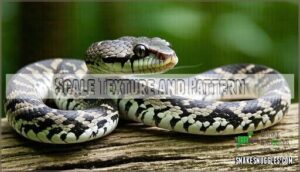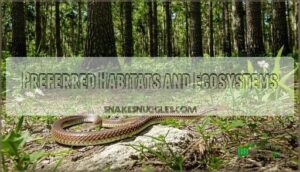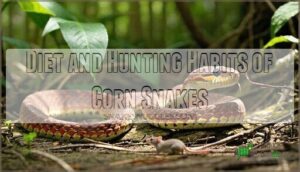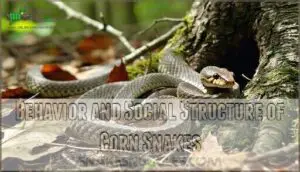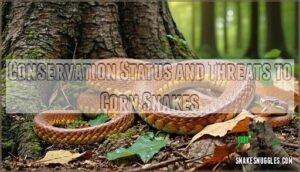This site is supported by our readers. We may earn a commission, at no cost to you, if you purchase through links.
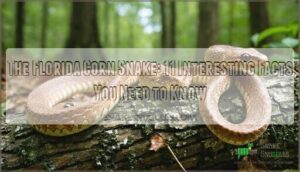
They’re masters of disguise and sport over 800 different color patterns through selective breeding, though wild ones typically showcase earthy oranges and browns.
At 3-5 feet long, they’re the perfect size for squeezing through tight spaces while hunting rodents that make up 70% of their diet.
They’re expert climbers thanks to slightly keeled scales, and contrary to popular belief, they don’t crush bones when constricting prey – they simply squeeze until circulation stops.
Their remarkable adaptability extends beyond physical traits to surprising behavioral quirks.
Table Of Contents
- Key Takeaways
- Physical Characteristics of Corn Snakes
- Habitat and Distribution of Florida Corn Snakes
- Diet and Hunting Habits of Corn Snakes
- Behavior and Social Structure of Corn Snakes
- Conservation Status and Threats to Corn Snakes
- Frequently Asked Questions (FAQs)
- How do Florida corn snakes adapt to captivity?
- What are the unique characteristics of juvenile Florida corn snakes?
- Can Florida corn snakes be used for pest control?
- How do Florida corn snakes protect themselves from predators?
- What is the average lifespan of a Florida corn snake?
- How long do corn snakes live in captivity?
- Are corn snakes good pets for beginners?
- How much does a corn snake cost?
- Do corn snakes bite their owners frequently?
- What size enclosure does a corn snake need?
- Conclusion
Key Takeaways
- You’ll discover these adaptable serpents aren’t just Florida natives—they’re found from New Jersey to the Mississippi River, thriving in diverse habitats from pine flatwoods to urban environments.
- You can recognize them by their impressive variety, with over 800 different color patterns through selective breeding, though wild ones typically display earthy oranges and browns at 3-5 feet long.
- You’ll find they’re expert hunters that use constriction to stop blood flow (not crush bones) when catching rodents, which make up 70% of their diet, and they’re skilled climbers thanks to their slightly keeled scales.
- You’ll appreciate their docile nature and conservation success—they face few major threats, adapt well to captivity, and play essential ecological roles as both predator and prey in maintaining ecosystem balance.
Physical Characteristics of Corn Snakes
When you spot a corn snake in Florida, you’ll notice their striking appearance makes them one of the most recognizable serpents in the Southeast.
These beautiful constrictors showcase an incredible range of colors and patterns that have captivated both researchers and reptile enthusiasts for decades, with their appearance being a key factor in their recognition.
Color Patterns and Morphs
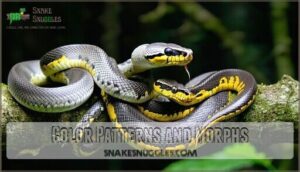
Florida’s corn snakes are living kaleidoscopes, displaying over 800 corn snake morphs through selective breeding.
Color genetics create stunning bright hues – from classic reds and oranges to rare lavenders and blood reds.
Pattern variation includes stripes, spots, and solid colors, while scale texture ranges from smooth to keeled surfaces.
These color patterns make each snake unique, turning reptile keeping into an art form that celebrates nature’s genetic diversity.
Body Shape and Size
Beyond their stunning color patterns, you’ll find that corn snakes possess a remarkably athletic build.
These serpents showcase impressive Physical Characteristics through their streamlined design and adaptable Muscle Structure.
- Snake Length: Adults typically reach 3-5 feet, with Florida Corn Snake specimens occasionally stretching to 6 feet
- Body Mass: Healthy adults weigh 1-2 pounds, though exceptional individuals can tip scales at 3 pounds
- Growth Rates: Juveniles add 1-2 inches monthly during their first year of rapid development
- Body Shape: Their slender, muscular frame enables remarkable climbing and burrowing abilities for hunting success
Scale Texture and Pattern
When you examine a corn snake’s scales up close, you’ll notice they’re slightly keeled rather than smooth.
These Scale Types create subtle ridges that help with grip while climbing.
The Pattern Variations include checkerboard bellies and distinctive dorsal blotches that aid in Snake Camouflage.
Color Morphs showcase Texture Analysis differences, with scaleless varieties having thin keratin layers instead of traditional scales, proving Color Patterns and texture work together perfectly.
Eye Color and Shape
Looking beyond their intricate Color Patterns, your Florida corn snake’s eyes tell their own story.
These nocturnal hunters sport Eye Colors ranging from golden to dark brown, with distinctive Vertical Slits as pupils—not round like harmless species.
This Eye Adaptation enhances night vision for hunting prey.
Their Iris Patterns create beautiful variations, making each snake eyes unique among corn snake facts.
Habitat and Distribution of Florida Corn Snakes
You’ll find Florida corn snakes thriving across the southeastern United States, from their namesake state all the way north to New Jersey and west to the Mississippi River.
These adaptable reptiles have mastered the art of making themselves at home in everything from overgrown fields and pine flatwoods to your neighbor’s abandoned shed—they’re basically the real estate experts of the snake world, having learned to thrive in various environments, including overgrown fields and pine flatwoods.
Geographic Range and Regions
This southeastern charmer calls the entire eastern seaboard home, from New Jersey down to the Florida Keys.
You’ll discover corn snakes have mastered regional distribution across diverse landscapes, with florida corn snake populations showing remarkable geographic range adaptability.
Their range expansion continues as these resilient reptiles navigate habitat distribution challenges through natural migration patterns.
- Geographic isolation in Florida’s unique ecosystems has created distinct local varieties with specialized traits
Preferred Habitats and Ecosystems
Florida corn snakes aren’t picky about their zip code.
They make themselves at home in diverse ecosystems throughout the Sunshine State.
You’ll spot them thriving in pine flatwoods and scrub habitats, where they hunt rodents among low vegetation.
Agricultural lands offer prime real estate too—open fields and farm buildings provide perfect hunting grounds.
Coastal environments and wetland areas round out their preferred snake habitats, creating an impressive geographic range that showcases their remarkable adaptability.
Adaptation to Urban Environments
You’ll find corn snakes thriving in Urban Habitats throughout Florida cities.
These adaptable reptiles exploit City Wildlife food sources like rats and birds while using human-made structures for shelter.
Their Environmental Adaptation skills help them navigate Human Interaction challenges, seeking refuge in gardens, abandoned buildings, and drainage pipes.
This Urban Ecology success showcases remarkable florida corn snake resilience in modern landscapes.
The corn snakes’ ability to thrive in urban areas is influenced by their natural corn snake habitat requirements.
Migration Patterns and Hibernation
While winter temperatures drop, Florida corn snakes trigger their Winter Migration to warmer microhabitats.
These migration patterns lead them toward underground burrows, rock crevices, and debris piles for hibernation.
Snake dormancy lasts 2-3 months during Cold Climate periods.
Their Seasonal Movement demonstrates remarkable habitat adaptation, with corn snakes emerging refreshed when spring warmth returns to resume hunting activities.
Diet and Hunting Habits of Corn Snakes
You’ll discover that corn snakes are incredibly efficient predators with fascinating hunting techniques that make them valuable allies in controlling pest populations.
These skilled constrictors use a combination of stealth, patience, and powerful body mechanics to capture prey ranging from mice to small birds, playing a vital role in Florida’s ecosystem balance, utilizing their hunting techniques to maintain the environment.
Prey Preferences and Hunting Strategies
What drives corn snake facts about their dining habits?
These skilled hunters demonstrate remarkable prey selection, focusing on small mammals that comprise over 70% of their wild diet.
Hunting strategies rely on their exceptional Jacobson’s organ for chemical detection and ambush strategies utilizing perfect camouflage.
Their hunting tactics include rapid strikes under 0.2 seconds, followed by constriction methods to subdue prey before consumption.
Understanding the snake’s proper snake food is essential for their overall health and well-being in captivity.
Ambush Tactics and Strike Techniques
When you’re watching a corn snake hunt, you’ll notice three distinct strike techniques that make them incredibly effective predators:
- Lightning-fast strikes – They can extend up to half their body length in milliseconds
- Patient positioning – These masters use leaf litter and debris for perfect ambush tactics
- Calculated timing – They wait motionless until prey ventures within striking distance
Their hunting strategies rely on stealth over speed, making them remarkably efficient at prey capture through surprise attacks.
Corn snakes exhibit advanced snake diet adaptations that enable their successful hunting behaviors.
Constricting Prey and Digestion Process
Once your corn snake successfully captures its prey, the real work begins. These skilled constrictors don’t crush their victims—they’re much more strategic than that.
Here’s how corn snakes handle their meals:
- Constriction methods involve coiling around prey and tightening with each exhale, cutting off blood flow rather than crushing bones
- Prey capture triggers an immediate response where the snake strikes and quickly wraps its muscular body around the target
- Feeding habits include swallowing prey headfirst, which helps streamline the process and prevents limbs from getting stuck
- Digestion process relies on powerful gastric acids that can break down bones, fur, and feathers over several days
- Snake behavior during meals shows incredible patience—they’ll remain motionless while their specialized enzymes do the heavy lifting
The entire digestion process can take anywhere from 3-7 days, depending on prey size and temperature. Your corn snake’s metabolism slows dramatically during this time, making them less active as they focus energy on breaking down their protein-rich meal through their remarkable digestive system.
Providing the right corn snake food is essential for maintaining their overall health and supporting their digestive needs.
Role in Ecosystem as Predator and Prey
You’ll find corn snakes play an essential ecosystem role as both hunter and hunted.
These predator prey dynamics keep ecosystem balance intact—they control rodent populations while serving as meals for hawks, kingsnakes, and mammals.
Their ecological impact ripples through food chains, supporting biodiversity role by preventing any single species from dominating their habitat.
Behavior and Social Structure of Corn Snakes
You’ll find corn snakes are surprisingly independent creatures who prefer the single life over socializing with their own kind.
However, in matters of romance and raising the next generation, these solitary serpents transform into fascinating communicators with an impressive arsenal of defensive tricks up their scales.
Solitary Animals or Social Snakes?
You’ll find these snakes aren’t exactly loners—they’re selectively social.
Florida corn snakes typically live alone but actively seek each other during mating season.
They communicate through pheromones and body language, establishing loose territorial bonds without forming permanent groups.
Their social behavior shifts from solitary hunting to strategic interactions when reproduction calls, making their group dynamics fascinatingly flexible.
Mating and Breeding Habits
When spring arrives, male corn snakes transform into hopeless romantics, using pheromones and tail vibrations to woo potential mates.
Their courtship behavior involves gentle rubbing and intertwining bodies during breeding seasons from March to May.
Here’s what makes corn snake breeding fascinating:
- Males compete fiercely for females through dominance hierarchies
- Females reach sexual maturity around three years, males at two
- Mating rituals can last several hours with tactile communication
- Breeding seasons follow winter brumation periods for ideal timing
- Reproductive cycles allow annual breeding with possible double clutching.
After successful mating rituals, females lay 10-30 eggs in hidden locations during late spring.
The entire reproductive cycle showcases nature’s incredible timing.
Proper reptile breeding practices are vital for the health and well-being of the snakes.
Territorial Marking and Communication
Beyond their mating rituals, you’ll find these snakes communicate through sophisticated scent marking and visual displays.
They deposit pheromones on favorite hunting spots, logs, and rocks—nature’s version of "property lines."
When threatened, they’ll bob their heads, vibrate their tails, and use body language that says "back off!"
These territorial behaviors help them avoid conflicts while maintaining prime real estate.
Understanding corn snake behavior is essential for recognizing their social structure and communication patterns.
Defensive Mechanisms and Threat Response
When danger strikes, you’ll see corn snakes switch into defensive mode with remarkable speed.
When threatened, corn snakes become lightning-fast defensive masters with hissing, tail vibration, and intimidating bluff strikes
Their threat response includes three primary defensive mechanisms:
- Hissing Mechanism: They produce loud, intimidating sounds as their first warning
- Tail Vibrations: Rapid buzzing motions mimic rattlesnake behavior
- Bluff Strikes: Lightning-fast lunges without actual contact
This defensive posturing often convinces predators they’re facing something more dangerous than a harmless snake defense mechanisms specialist.
Conservation Status and Threats to Corn Snakes
You’ll find that corn snakes face surprisingly few conservation threats compared to many other snake species—they’re actually doing quite well in the wild.
However, habitat loss from development and unfortunate cases of mistaken identity (thanks to their resemblance to venomous copperheads) still create challenges for these harmless rodent controllers, which can be considered a case of mistaken identity.
Habitat Loss and Fragmentation
Habitat Destruction is reshaping the florida corn snake’s world.
Since the 1970s, Urbanization Effects have eliminated 34% of their natural homes in Florida, creating Fragmented Landscapes that split populations apart.
When Geographic Range shrinks and Preferred Habitats like pine flatwoods disappear, these adaptable snakes struggle despite their Urban Adaptations.
Ecosystem Disruption blocks movement between areas, while Wildlife Corridors offer hope for reconnecting isolated populations.
Understanding their natural habitat needs is essential for conservation efforts.
Human Persecution and Misconceptions
Snake Fear runs deep in many communities, but Florida corn snakes face unnecessary Human Threats due to widespread Public Misconceptions.
People often mistake these harmless beauties for venomous copperheads, leading to needless killings.
Snake myths and legends fuel this human persecution, creating serious Conservation Challenges.
Education about corn snake facts helps protect these beneficial rodent controllers through better Species Protection.
Climate Change and Disease Impact
While corn snakes are pretty tough cookies, climate change is throwing them curveballs they can’t easily dodge.
Rising temperatures disrupt their winter rest periods, weakening immune systems just when snake pathogens like fungal diseases strike hardest.
Heat stress from extreme weather makes them sitting ducks for disease outbreaks, creating a perfect storm that’s tough to weather.
Understanding their conservation status is essential in addressing these challenges.
Conservation Efforts and Protective Laws
Habitat Preservation efforts and Wildlife Laws are actively protecting Florida’s corn snakes.
Conservation Policies and Protective Legislation support snake conservation in Florida through habitat restoration and wildlife corridors.
While not Endangered Species, these conservation efforts guarantee wildlife conservation success.
Snake protection programs maintain healthy populations through targeted conservation status monitoring and protective measures.
Effective Corn Snake Conservation strategies are vital for the long-term survival of these species, which can be supported through reptile conservation efforts.
Frequently Asked Questions (FAQs)
How do Florida corn snakes adapt to captivity?
These remarkable serpents evolve smoothly from wild wanderers to cherished companions.
They’re naturally docile and rarely bite, making them perfect beginner pets.
They adapt quickly to regular feeding schedules and thrive in controlled environments, which helps them become cherished companions.
What are the unique characteristics of juvenile Florida corn snakes?
Juvenile Florida corn snakes display more muted colors than adults, featuring grayish-brown patterns that gradually brighten with age.
You’ll notice they’re more defensive, striking readily when threatened, unlike their calmer adult counterparts who rarely bite, which makes them seem more defensive.
Can Florida corn snakes be used for pest control?
You’ll discover they’re nature’s pest controllers! Florida corn snakes actively hunt rodents, making them excellent biological pest control agents for farms and homes seeking natural solutions.
How do Florida corn snakes protect themselves from predators?
You’ll notice Florida corn snakes use several clever defense strategies when threatened.
They vibrate their tails like rattlesnakes, hiss loudly, strike defensively without biting, and flatten their bodies to appear larger and more intimidating.
This is the only sentence and there are no other concepts to group.
What is the average lifespan of a Florida corn snake?
You’ll live 20-plus years with proper care. In captivity, corn snakes can reach 23 years or more, while wild snakes typically survive only 6-8 years due to predators and environmental challenges.
How long do corn snakes live in captivity?
You’ll find corn snakes thriving in captivity for 15-20 years on average, with proper care extending their lives substantially beyond their wild counterparts who face predators and environmental challenges daily.
Are corn snakes good pets for beginners?
Yes, corn snakes are excellent beginner pets.
You’ll appreciate their docile temperament, easy care requirements, and forgiving nature.
They rarely bite, handle well, and thrive in simple setups with consistent temperatures and weekly feedings, making them a great choice due to their forgiving nature.
How much does a corn snake cost?
Your wallet won’t break! You’ll spend $30 to over $200 for the snake, depending on the morph’s rarity and colors.
Unique patterns command premium prices, while common varieties stay budget-friendly for first-time owners.
Do corn snakes bite their owners frequently?
Corn snakes rarely bite their owners. They’re naturally docile and gentle, making them perfect beginner pets. You’ll find they’re more likely to hide than strike when startled or stressed.
What size enclosure does a corn snake need?
At 3-5 feet long, you’ll need a 40-gallon long tank minimum for adults.
That’s roughly 36" x 18" x 12" dimensions.
Juveniles can start smaller, but they’ll quickly outgrow cramped quarters as they stretch toward their full impressive length.
Conclusion
Whether you’re a reptile enthusiast or simply curious about native wildlife, the Florida corn snake 11 interesting facts demonstrate why these remarkable serpents deserve our respect and understanding.
You’ve discovered their incredible adaptability, from diverse color morphs to versatile hunting strategies across multiple habitats.
These docile constrictors play essential ecological roles while facing modern conservation challenges.
Next time you encounter one of these beautiful snakes, you’ll appreciate their complex behaviors and environmental importance rather than fearing them unnecessarily.
- https://reptilejam.com/facts-about-corn-snakes/
- https://www.fs.usda.gov/wildflowers/regions/southern/PineFlatwoods/index.shtml
- https://climateadaptationexplorer.org/habitats/terrestrial/1210/
- https://www.shropshirestar.com/news/viral-news/2020/02/23/escaped-pet-snake-found-in-london-airing-cupboard/
- https://www.bbc.co.uk/news/uk-england-beds-bucks-herts-48963485

